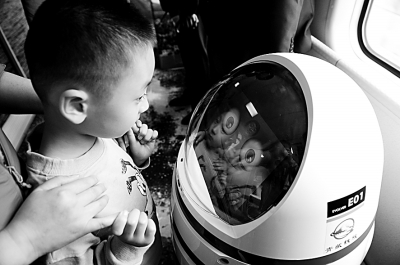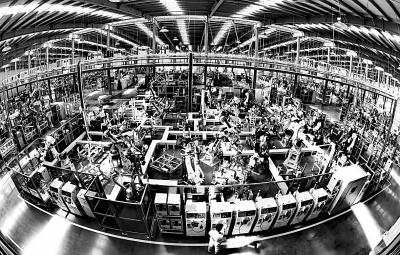·Core Tips·
■ China has many world-leading scientific and technological achievements in the fields of drones, Internet, cloud computing, biomedicine, and sharing economy.
■ Artificial intelligence is expected to boost the annual growth rate of China's economy by 2035, and promote China's labor productivity by 27%.
■ China must find a way out in innovation, persist in innovation drive, and be brave in change, in order to break through the bottleneck of development and become the leader of the new industrial revolution.
Recently, high-tech products such as drones, smart driving cars, intelligent robots, and VR (virtual reality) devices have emerged, and the artificial intelligence landscape has slowly begun. The arrival of the fourth industrial revolution is making people's production and life quietly change...
The so-called fourth industrial revolution, that is, the new industrial revolution represented by intelligence as the core and artificial intelligence and Internet of Things. Klaus Schwab, founder and executive chairman of the World Economic Forum, in his book The Fourth Industrial Revolution, unmanned vehicles (automobiles and drones), 3D printing, advanced robots, new materials The Internet of Things and genetic engineering are listed as core driving technologies.
How can we cope with the opportunities and challenges brought about by the new industrial revolution in the past two industrial revolutions and the efforts of China in the third industrial revolution? Can it be a new leader?
1. What did the fourth industrial revolution change?
[case]
In the unmanned supermarket “Amoy Coffee”, customers can enter the store by scanning the code and purchase the products at will. When leaving the store, they will go through a “payment gate”, the system will automatically deduct the money and remind the user to deduct the amount... Experts said that The novel shopping experience and cost savings of unmanned supermarkets are just the appearance. The key is that they can use the artificial intelligence, Internet of Things, big data and other technologies to master the shopping habits of customers and achieve precise marketing.
“We have realized dozens of smart kitchen appliances such as soya-bean milk makers and rice cookers.” Han Run, vice president of Jiuyang Co., Ltd. said that under the pressure of users, the company has carried out intelligent transformation and the products have been sold. To more than 50 countries and regions in the world, annual sales of more than 7 billion yuan, with 2047 patented technologies.
In the smart factory of Zhengtai New Energy Hangzhou, the reporter saw that many unmanned transport vehicles and robotic arms are working in an orderly manner. According to reports, after the intelligent transformation, the number of employees in the production workshop has dropped significantly, saving a lot of labor costs, and the production efficiency has been greatly improved.

Intelligent robot on a tourist train. Xinhua News Agency
Experts said that the intelligent transformation and upgrading will greatly increase the production efficiency of enterprises and reduce production costs, which will undoubtedly form new economic growth points.
According to statistics, in the first five months of this year, the main business income of China's strategic emerging industries key industries increased by 13.3% year-on-year, among which the profit margins of new energy power generation, pharmaceutical manufacturing and electronic measuring instruments industry reached 32.1%, 10.7% and 10.1% respectively; In May, the added value of high-tech industries and equipment manufacturing increased by 11.3% and 10.3% respectively.
According to the latest report released by Accenture, an international management consultancy, by changing the way of working and opening up new sources of value and growth, artificial intelligence is expected to boost China's annual economic growth rate by 2035 and boost China's labor productivity by 27%.
In fact, the new kinetic energy generated by new technologies is the epitome of the “change” brought about by the fourth industrial revolution. As Jin Jianmin, a researcher at the Fujitsu Institute of Economic Research in Japan, said, the new technology of the fourth industrial revolution will promote the industrial revolution, greatly increase production efficiency and bring profound changes to social development.
'Now China has many world-leading scientific and technological achievements in the fields of drones, Internet, cloud computing, biomedicine, and sharing economy. These will become important driving forces for China's economy.' Schwab believes that China will become The leader of the fourth industrial revolution.
2. How does China find the key to the future?
[Phenomenon]
Papermaking, printing, gunpowder, and compass, the four inventions of ancient China have had an important impact on the development of world civilization. However, why did modern science and industrial revolution not occur in modern China? This 'Li Joseph puzzle' can not help but think deeply. A few days ago, Piero Sgaroufi, a visiting professor at Stanford University and author of The Essence of Intelligence, said in an interview that the key to explaining this phenomenon is innovation.
In the view of Pierrot Sgaruf, China has innovative historical and cultural genes, such as China's WeChat, Alipay and other applications today, which have a better user experience than similar foreign products.
According to Schwab, he is a big fan of Dajiang drones. He mentioned that the drones produced by Shenzhen Dajiang Innovation Technology Co., Ltd. can be used for aerial photography and remote sensing mapping. 'It is the best drone in the world.'
Goer Co., Ltd. is a leading company in China's electro-acoustic industry. Over the past 10 years, the company has become an important supplier to Samsung and Sony by virtue of manufacturing advantages such as sensors. 'We have long-term accumulation in product development, design, etc. It is easier to turn good ideas into good products in innovation,' said Ji Yong, vice president of the company.

(Source: China Industrial Network)